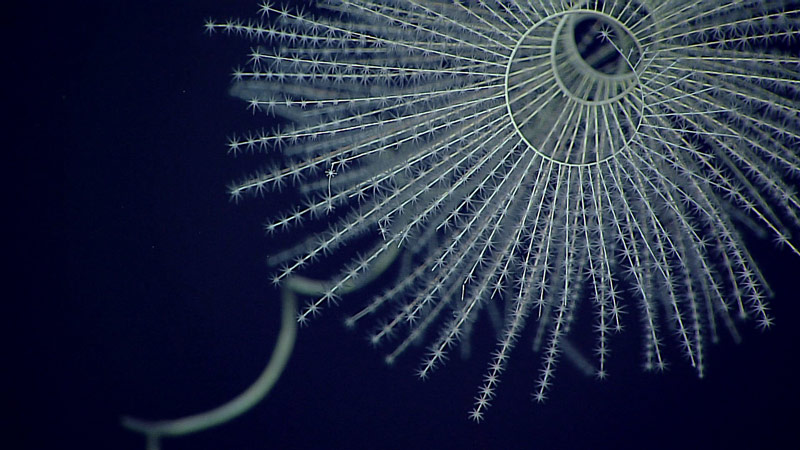
This is a great look at the spiral shape of an Iridogorgia. Image courtesy of the NOAA Office of Ocean Exploration and Research, Deepwater Wonders of Wake. Download larger version (jpg, 1.1 MB).

This is a great look at the spiral shape of an Iridogorgia. Image courtesy of the NOAA Office of Ocean Exploration and Research, Deepwater Wonders of Wake. Download larger version (jpg, 1.1 MB).
Dive 8: Fish Faces
There was something fishy about Dive 8 — it was indeed the fishiest dive of the expedition, with a variety of eels, swimmers, squatters, a big ray, and even a large shark. The dive took place north of Wake Island, on an unnamed seamount at a depth of ~1,025 meters. Video courtesy of the NOAA Office of Ocean Exploration and Research, Deepwater Wonders of Wake. Download larger version (mp4, 108 MB).
Today's dive was the first of a couple of shallower dives targeting the precious coral resources and fishes around Wake Island. The vehicles arrived at the seafloor at 22:26UTC, at a depth of 1,020 meters. The dive location was selected to optimize shallow water observation of fish and corals, and the northern side of the atoll accommodated this with some of the shallowest depths while maintaining a safe distance from the fringing reef. Wake Island (atoll) is the only geologic structure within the Wake Atoll Unit of the Pacific Remote Islands Marine National Monument that reaches sea level (thus enabling this type of dive), and as expected, the bottom at this short distance from the atoll consisted of mainly reef debris. Overall, the bottom was characterized with three types of materials: loose sand, cobbles and boulders, and large rocky formations consisting of layers of reef debris. The initial landing site was located on a scree (talus) slope of mainly sand (shell and coral fragments). During this dive, the most commonly observed animals were a variety of fish and shrimp. The sandy terrain also hosted a number of sea cucumbers, while anemones were found on a number of the cobbles and boulders. Other observations included a feather star and ctenophore. On the more massive layered carbonate, we observed a small number of sponges and several types of corals were sampled just prior to leaving the seafloor.